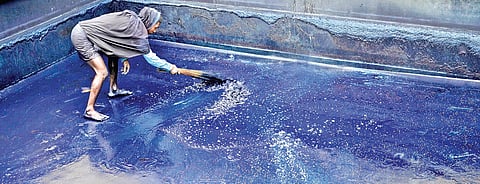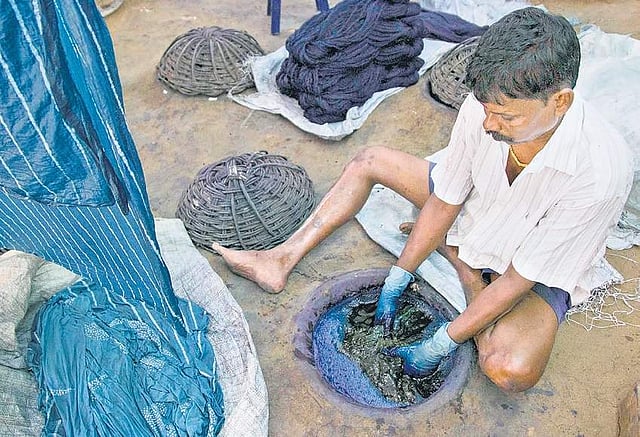

For the past 25 years, Jesus Ciriza Larraona has worked with the colour Indigo. And during this phase, Indigo has been somewhat like an indecisive lover, letting him revel in the longing that only uncertainty brings. What makes a colour as common as the blue in the deep midnight sky, so irresistible to some? The answer, they say, is because it is as simple and as complicated as almost everything that it paints.
With large national and international clothing companies increasingly taking the green route, playing with natural dyes and fabrics, the natural Indigo dye is in vogue like never before.
However, says Jesus, founder of natural dyeing unit ‘The Colours of Nature’ in Auroville, the country is now having to re-learn the art of dyeing with natural indigo. From being one of the oldest known natural Indigo dyeing centres in the world, it has turned into a country groping in the dark to find the perfect technique. “Over the last 100 years, all traditional dyers in the country had moved to synthetic dyeing — it’s cheaper and easier. Now, we have to piece together the art of natural dyeing from whatever little the families who once practised it remember,” he said.

Arduous journey
Jesus ropes in traditional dyers from across the country to his workshop in Auroville in an attempt to learn and revive traditional Indigo dyeing. “It is difficult because there is no set formula. A few hundred years ago, the urine of children and drunk men were used in natural indigo dyeing. The quality used to be so good during those times. People would smell the fabric and if they couldn’t smell urine, would refuse to buy it.” For reasons only too obvious, the technique did not stand the test of time, quickly growing unpopular and anaerobic fermentation took its place. However, even for that, there is no set formula, say dyers.
Called the king of dyes, Indigo stands apart from other dyes since it is dyed through living fermentation in a solution called a vat filled in pots.
In the village of Guledgudda in Karnataka, the Hasilcar family had dyed Indigo for generations. Subhash Hasilcar, a septuagenarian, one of the few to pass on his knowledge to ‘The Colours of Nature’, remembered the routine but forgot the nuances, like being able to understand the condition of pots by smell. His villagers switched to synthetic dyeing over 70 years ago, and are happy doing what they do with no plans to take up full-fledged traditional dyeing.
Not so profitable
The Colours of Nature now has about 30 pots and a total capacity of 60,000 litres in its sprawling premises. But, even with this, they can only dye as many clothes as a single barrel of synthetic dye, and therein lies their biggest challenge. “Many of the manufacturers who say they have used natural dyes are lying. That is why we have unfair competition. Consumers must be more aware of how the manufacturers source their products,” said Jesus, as he cups soluble yellow-green Indigo from the vat to his palms. After a few seconds of moving it within his palm, it turns into Indigo.
“Soluble Indigo is yellow-green. When it is oxidised, it drops off hydrogen to take oxygen, turning blue.”
Although the colour is in vogue now, it has taken over a century to shed the shades of red that it had taken on during the Indigo revolt against the British rule, when farmers were forcibly made to cultivate Indigo. Planters reportedly paid them a meagre 2.5% of the market price, driving them into poverty and starvation. A commission was eventually set up to ascertain the conditions under which the dye was produced. E W L Tower, in the committee’s report that followed, noted that “not a chest of Indigo reached England without being stained with human blood”

From 1896-1897, about 16,88,900 acres of land were under indigo cultivation in India. The British East India company exported about 19,000 tonnes of indigo from India. However, production virtually ceased in the 1920s.
From fields of green, a mystic blue
From the green fields of Villupuram, where about 400 acres of Indigofera tinctoria are cultivated, come most of the country’s natural Indigo. Its humid climate makes the Indigo cultivated here one of the best in terms of quality, while the unavailability of water makes it the best option for farmers. “It is usually sown in November and harvested in February. Irrigation is only required once in 20 days. Moreover, the second crop can be harvested in just 50 days and you can grow up to four crops a year,” said Anbalagan, a fourth generation Indigo farmer.
Muthusamy, another farmer in Tindivanam, who had recently taken to Indigo cultivation, said he had no regrets with the decision to grow indigo, making a profit of around `15,000 a crop.
The fresh leaves of Indigo are steeped in water for 18 hours, pressed before oxidising the bluish green water that is left behind until it turns deep blue.
This process again, as simple as it may sound, is fraught with challenges. Said Balachander A of Tindivanam, “You must know exactly when to stop the oxidation process that takes an average of two hours. Understanding only comes with time.” According to Balachander, though the crops are sourced from the same region, the time of oxidation varies from crop to crop. “If the oxidation process is extended by even half an hour, 90 per cent of the batch would be lost,” he explains.
This used to be the primary challenge for Indigo manufacturers until the GST was introduced. From being completely exempted from tax under the ‘herbal’ category, natural Indigo is now taxed at 18 per cent. “It has also eliminated smaller players, because procuring from them may lead us to trouble,” said Balachander.
Synthetic vs natural
Indian connection
India is one of the oldest known centres of Indigo dyeing. In fact, the country gave the dye its name. The Greeks named it ‘Indikón’ (Indian). The Romans gave it the term Indicum, which later became Indigo
3–12
Indigo required for a pair of blue jean trousers. Indigo carmine, or indigo, is an indigo derivative which is also used as a colorant. About 20 thousand tonness are produced annually, again mainly for blue jeans